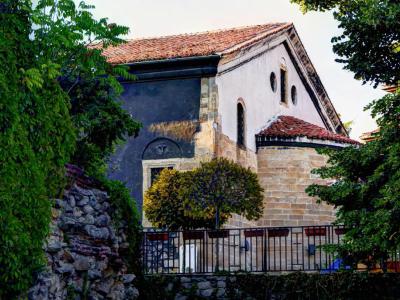
Church of St. Constantine and Helena, Plovdiv
The Church of Saints Constantine and Helena stands as one of the oldest Christian churches in the city, forming an integral part of the Architectural Complex known as "The Ancient Plovdiv." The roots of this historic church trace back to the year 304 when the martyrs Severin and Memnos met their tragic end at the very site where the church now stands. Over the years, the church faced multiple demolitions and reconstructions, undergoing numerous transformations. The Church of Saints Constantine and Helena, as we know it today, emerged in 1810.
A distinctive feature of the church is its iconostasis, which was crafted in Vienna. The iconostasis is a testament to Baroque artistry, notable for its opulent gilding and polychromatic decoration. While completed in 1836, the gilding was executed at a later date. The first row of icons on the iconostasis was painted by the celebrated Bulgarian artist Zahari Zograf. Additionally, the church houses icons dating back to the 14th and 15th centuries. Yoan Pashkula also crafted the canopy over the Holy See and the Bishop's throne, while Dimitar Stanishev of the Debar school contributed the small iconostasis located in the central part of the temple.
In 1864-1866, the church underwent a comprehensive painting project, overseen by artists Stefan Andonov and Atanas Gyudzhenov of Pazardzhik. These meticulous efforts resulted in the preservation of the original frescoes, making the Church of Saints Constantine and Helena one of the few Plovdiv temples with its original frescoes still fully intact.
In the 1950s, excavation efforts beneath the apse of the church unearthed intriguing discoveries, including a rectangular tower associated with the defense of the eastern fortress gate known as Hisar Kapia. An ossuary was also discovered, serving as the final resting place for the remains of generations of noble Plovdiv citizens.
A distinctive feature of the church is its iconostasis, which was crafted in Vienna. The iconostasis is a testament to Baroque artistry, notable for its opulent gilding and polychromatic decoration. While completed in 1836, the gilding was executed at a later date. The first row of icons on the iconostasis was painted by the celebrated Bulgarian artist Zahari Zograf. Additionally, the church houses icons dating back to the 14th and 15th centuries. Yoan Pashkula also crafted the canopy over the Holy See and the Bishop's throne, while Dimitar Stanishev of the Debar school contributed the small iconostasis located in the central part of the temple.
In 1864-1866, the church underwent a comprehensive painting project, overseen by artists Stefan Andonov and Atanas Gyudzhenov of Pazardzhik. These meticulous efforts resulted in the preservation of the original frescoes, making the Church of Saints Constantine and Helena one of the few Plovdiv temples with its original frescoes still fully intact.
In the 1950s, excavation efforts beneath the apse of the church unearthed intriguing discoveries, including a rectangular tower associated with the defense of the eastern fortress gate known as Hisar Kapia. An ossuary was also discovered, serving as the final resting place for the remains of generations of noble Plovdiv citizens.
Want to visit this sight? Check out these Self-Guided Walking Tours in Plovdiv. Alternatively, you can download the mobile app "GPSmyCity: Walks in 1K+ Cities" from Apple App Store or Google Play Store. The app turns your mobile device to a personal tour guide and it works offline, so no data plan is needed when traveling abroad.
Church of St. Constantine and Helena on Map






Sight Name: Church of St. Constantine and Helena
Sight Location: Plovdiv, Bulgaria (See walking tours in Plovdiv)
Sight Type: Religious
Guide(s) Containing This Sight:
Sight Location: Plovdiv, Bulgaria (See walking tours in Plovdiv)
Sight Type: Religious
Guide(s) Containing This Sight:
Walking Tours in Plovdiv, Bulgaria
Create Your Own Walk in Plovdiv
Creating your own self-guided walk in Plovdiv is easy and fun. Choose the city attractions that you want to see and a walk route map will be created just for you. You can even set your hotel as the start point of the walk.
Roman Ruins Walking Tour
If you’re a fan of Spartacus, a warrior turned slave and gladiator, who led an uprising against the Roman Empire in the 1st century BC, you probably remember him being called a “Thracian dog” by his enemies. Now, Thrace is the name of the region that encompasses present-day Bulgaria and the Western Part of Turkey. Plovdiv, once known as Philippopolis, is one of its most important cities.
... view more
Tour Duration: 2 Hour(s)
Travel Distance: 3.3 Km or 2.1 Miles
... view more
Tour Duration: 2 Hour(s)
Travel Distance: 3.3 Km or 2.1 Miles
Plovdiv Introduction Walking Tour
Plovdiv is Bulgaria’s second-largest city and one of the oldest continuously inhabited cities in Europe. Nicknamed "The City of the Seven Hills," it boasts over 8,000 years of history, with traces of habitation dating back to the 6th millennium BC. Straddling the Maritsa River in south-central Bulgaria, Plovdiv's thick cultural layers reveal influences from Thracians, Romans,... view more
Tour Duration: 2 Hour(s)
Travel Distance: 2.7 Km or 1.7 Miles
Tour Duration: 2 Hour(s)
Travel Distance: 2.7 Km or 1.7 Miles


